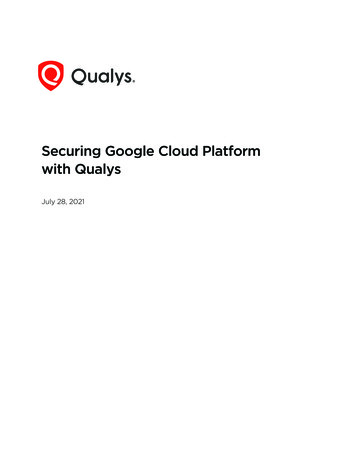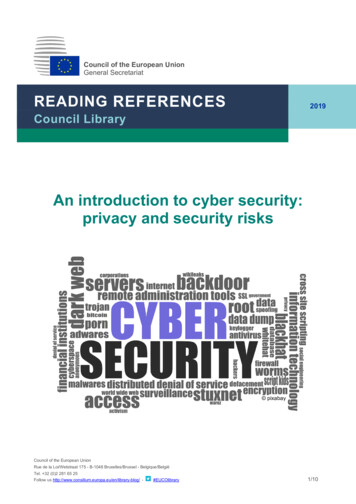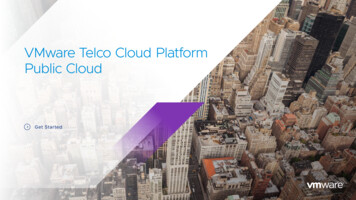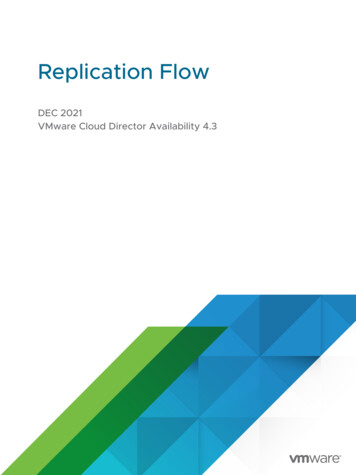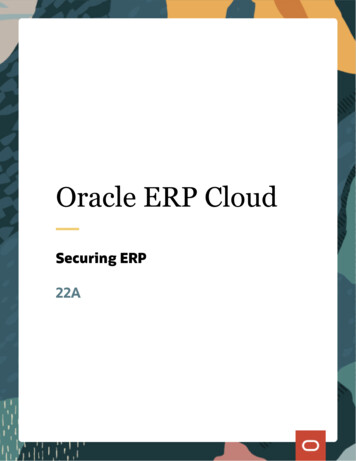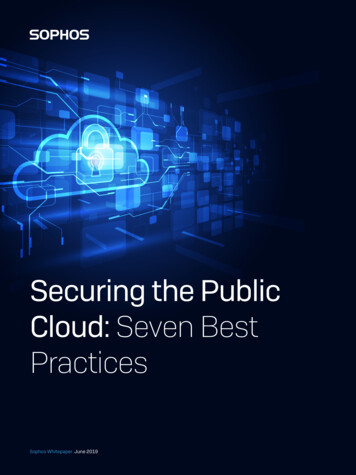
Transcription
Securing the PublicCloud: Seven BestPracticesSophos Whitepaper June 2019
Securing the Public Cloud: Seven Best PracticesContentsThe Toughest Challenges in Cloud Security3Seven Steps to Securing the Public Cloud5Step 1: Learn your responsibilities5Step 2: Plan for multi-cloud6Step 3: See everything6Step 4: Integrate compliance into daily processes6Step 5: Automate your security controls7Step 6: Secure ALL your environments (including dev and QA)8Step 7: Apply your on-premises security learnings8Introducing Sophos Cloud OptixConclusionSophos Whitepaper June 20199111
Securing the Public Cloud: Seven Best PracticesSecuring the Public Cloud:Seven Best PracticesWhat does success look like to you when it comesto securing applications in the public cloud?Perhaps it’s surviving the year without hitting the headlines fora data breach. Or being able to understand your organization’scloud infrastructure footprint so you can accurately secure it?Maybe you want to ensure compliance audits go off withouta hitch? Or improve collaboration on security and compliancefixes with siloed compliance and development teams?Whatever you want to do, this guide can help. It exploresthe seven most important steps in securing the publiccloud, providing practical guidance that every organizationcan follow. It includes the results of threat research fromSophosLabs into the frequency with which cybercriminalstarget cloud-based instances. This guide also exploreshow Sophos Cloud Optix enables organizations toaddress their security and visibility challenges.Spinning up new instances in Amazon Web Services (AWS), Microsoft Azure, orGoogle Cloud Platform (GCP) is simple. The hard part for operations, security,development, and compliance teams is keeping track of the data, workloads,and architecture changes in those environments to keep everything secure.While public cloud providers are responsible for the security of the cloud (thephysical datacenters, and the separation of customer environments and data),responsibility for securing the workloads and data you place in the cloud lies firmlywith you. Just as you need to secure the data stored in your on-premises networks,so you need to secure your cloud environment. Misunderstandings around thisdistribution of ownership is widespread and the resulting security gaps havemade cloud-based workloads the new pot of gold for today’s savvy hackers.Sophos Whitepaper June 20192
Securing the Public Cloud: Seven Best PracticesThe Toughest Challenges in Cloud SecurityGiven the simplicity and cost-effectiveness of the public cloud, it’s no surprisethat more and more organizations are turning to Amazon Web Services,Microsoft Azure, and Google Cloud Platform. You can spin up a new instancein minutes, scale resources up and down whenever you need while onlypaying for what you use, and avoid high upfront hardware costs.While the public cloud solves many traditional IT resourcing challenges, itdoes introduce new headaches. The secret to effective cybersecurity in thecloud is improving your overall security posture: ensuring your architectureis secure and configured correctly, that you have the necessary visibilityinto your architecture, and importantly, into who is accessing it.While this sounds simple, the reality is anything but.The rapid growth of cloud usage has resulted in a fractured distribution of data,with workloads spread across disparate instances and, for some organizations,platforms. The average organization already runs applications in two publicclouds, while experimenting with another 1.8 public clouds ¹. This multi-cloudapproach compounds the visibility challenge for IT teams who need to jump fromplatform to platform to get a complete picture of their cloud-based estates.Lack of visibility into cloud-based workloads leads to both securityand compliance risks:Increased exposureGreater agility and improved time-to-market for products and services are hugemotivators for an organization to move to the public cloud. Doing this usuallyrequires the agility and responsiveness of a DevOps approach. For many, thisnew approach to development and product releases entails multiple developersworking across multiple platforms, and often in different time zones.Keeping track of the workloads wasn’t such an issue when development cycleslasted months or even years, but those days are over. You now need to keepup with multiple releases – sometimes on the same day. Tracking fast-pacedarchitecture changes, configuration updates, and security group settingsaround the clock is near impossible. It all adds up to a recipe for increasedexposure to cyber threats where vulnerabilities can be quickly exploited.Sophos Whitepaper June 20193
Securing the Public Cloud: Seven Best PracticesThreats to data, intellectual property, and servicesJust as organizations enjoy the automation benefits that the public cloud offers, so toodo cyber criminals. Today’s attackers increasingly canvass cloud environments and takeadvantage of native cloud provider APIs to automate deployments on new instances,breach open databases, change security settings, and lock out legitimate users.To quantify the issue, SophosLabs recently set up environments in 10 of themost popular AWS data centers in the world. The research revealed that:ÌÌWithin two hours, all 10 suffered login attempts ²ÌÌEach device saw an average of 13 login attempts per minute, or about 757 per hourThese startling results highlight the frequency with which cybercriminals are targetingcloud-based instances, using sophisticated, automated techniques. The challenge forsecurity teams lies in identifying and securing potential vulnerabilities before the attackers,and identifying unusual (attacker) behavior in real time to stop an attack in its tracks.Maintaining compliance standardsNo matter where your infrastructure and data is held, you need todemonstrate compliance with relevant regulations, including CIS,HIPPA, GDPR, and PCI or risk regulatory non-compliance.The challenge in the cloud is that environments change by the day, the hour,even by the minute. Whereas compliance checks every week or month mayhave worked for on-premises networks, they won’t cut it for the public cloud. Theneed for continuous compliance analysis can be a huge resource drain for teamsthat are managing cloud environments manually or with native tools. What’smore, once a compliance issue is identified, the fractured nature of security,development, operations and compliance teams within most organizationsmeans it is often challenging to address the situation in a timely manner.Sophos Whitepaper June 20194
Securing the Public Cloud: Seven Best PracticesSeven Steps to Securingthe Public CloudStep 1: Learn your responsibilitiesThis may sound obvious, but security is handled a little differently in the cloud. Publiccloud providers such as Amazon Web Services, Microsoft Azure, and Google CloudPlatform run a shared responsibility model – meaning they ensure the securityof the cloud, while you are responsible for anything you place in the cloud.Aspects such as physical protection at the datacenter, virtual separation of customerdata and environments – that’s all taken care of by the public cloud providers.You might get some basic firewall type rules to govern access to your environment.But if you don’t properly configure them – for instance, if you leave ports open to theentire world – then that’s on you. So you’ve got to learn your security responsibilities.Fig 1 provides an overview of these shared responsibilities– or if you prefer, watch the video here.Shared ResponsibilitySecurity ModelOnPremisesPublicCloudWhy?UsersEnforce authentication, define accessrestrictions, and track credential use.DataStop data loss, define and enforce who canaccess what data, while ensuring compliancestandards are met.ApplicationsPrevent application compromise through policy,patching, and security.Network ControlsTrack and enforce network access permissions.Host InfrastructureManage and secure operating systems, storagesolutions and related systems to preventunpatched bugs and privilege escalations.Physical SecurityRestrict physical access to systems and designredundancy to prevent single point of failure.CustomerPlatform ProviderFig 1. Sophos summarized view of the shared responsibility model. For each cloudprovider’s specific version visit sophos.com/public-cloud.Sophos Whitepaper June 20195
Securing the Public Cloud: Seven Best PracticesStep 2: Plan for multi-cloudMulti-cloud is no longer a nice-to-have strategy. Rather, it’s become a musthave strategy. There are many reasons why you may want to use multiple clouds,such as availability, improved agility, or functionality. When planning your securitystrategy start with the assumption that you’ll run multi-cloud – if not now, atsome point in the future. In this way you can future-proof your approach.Think about how you will manage security, monitoring, and compliance across multiplecloud providers, in separate systems and consoles. The easier the management experiencethe easier it is to cut incident response times, increase threat detection, and reducecompliance audit headaches. Not to mention aiding retention of valuable team members.Look for agentless solutions that allow you to monitor multiple cloud providerenvironments within a single SaaS console, reducing the number of tools, time, andpeople needed to manage security across multiple cloud accounts and regions.Step 3: See everythingIf you can’t see it, you can’t secure it. That’s why one of the biggest barriers to gettingyour security posture right is getting accurate visibility of your infrastructure.Take advantage of tools that provide a real-time visualization of network topologyand traffic flow, with a full inventory breakdown including hosts, networks,user accounts, storage services, containers, and serverless functions.For enhanced visibility, look for tools able to identify potential vulnerabilities within yourarchitecture so you can prevent a potential breach point. Potential risk areas include:ÌÌDatabases with ports open to the public internet thatcould allow attackers to access themÌÌPublic Amazon S3 Simple Storage ServicesÌÌSuspicious user login behaviors and API calls – such as multiplelogins to the same account at the same time, or a user loggingin from different parts of the world on the same dayStep 4: Integrate compliance into daily processesMoving workloads to the cloud introduces the challenge of meeting compliance regulationsacross a more distributed network, often involving regular development releases. To ensurecompliance, you need to create accurate inventory reports and network diagrams of yourcloud footprint, and ensure your compliance checklist is met in a dynamic environment.When it comes to meeting audit deadlines, often organizations fall back on the short-termfix of diverting resources from profitable business projects. Yet this is not sustainable longerterm and, as daily snapshots quickly become obsolete, this doesn’t provide the continuouscompliance monitoring needed for standards such as ISO 27001, HIPAA, and GDPR.Look for solutions that allow you to raise compliance standards without addedheadcount by providing real-time snapshots of your network topology, and automaticallydetecting changes to your cloud environments in real time. You’ll also want theoption to customize policy to meet the specific needs of your sector or vertical.Of course, reporting is only one aspect of compliance. You also need tobe able to address compliance failures. The challenge is that it is oftenSophos Whitepaper June 20196
Securing the Public Cloud: Seven Best Practiceshard to get the right people in operations, development, and complianceto work together due to lack of effective collaboration channels.To make the process of addressing compliance failures run smoothly, findsolutions that integrate with your existing ticketing solutions, including alertinformation that can be used to create, assign, and track issues to completion,ensuring important tasks are never lost, even during a release.Step 5: Automate your security controlsThe ability to automate processes is one of the joys of DevOps. But, just as your teamsenjoy automating deployment of infrastructure templates and scripts, saving hours ofdevelopment time, so you should also consider what security controls you can automate.In the collaborative framework of DevOps, security is a shared responsibility,integrated from end-to-end. This mindset led to the coining of the term “DevSecOps,”emphasizing the need to build strong security foundations into DevOps initiatives.The need for automated security is clear as cybercriminals increasingly takeadvantage of automation themselves in their attacks – for example, using stolenuser credentials to automate provisioning of instances for activities such ascryptojacking, changing account settings, or revoking legitimate users to avoiddetection. Indeed, the canvassing of cloud environments for vulnerabilities inpasswords, security group settings, and code are now commonplace.The two main reasons why attacks on public cloud environments succeed are thatthe architecture configuration is not secure, and that threat response hasn’t kept pacewith attackers. Automation of security controls is key to addressing these issues.To ensure the security of your public cloud environments, look for a solution that can:ÌÌAuto-remediate user access vulnerabilities and resources,with ingress from any source on any portÌÌIdentify suspicious console login events and API calls that suggestshared or stolen user credentials are being used by an attackerÌÌReport anomalies in outbound traffic to alert your organization toactivities such as cryptojacking or the exfiltration of dataÌÌReveal hidden application workloads from the behavior of the hostcomputer instance to highlight hidden exposure points (e.g. databases)Sophos Whitepaper June 20197
Securing the Public Cloud: Seven Best PracticesStep 6: Secure ALL your environments(including dev and QA)While the public cloud data breaches that made headlines tend to be those thathit an organization’s production cloud environment (the one your customersuse), attackers are just as likely to come after your computing power – on yourdevelopment and QA environments – for activities like cryptojacking.You need a solution that can secure your all environments (production, development,and QA) both reactively and proactively. The solution should be able to ingest youractivity logs (for example, VPC Flow logs and CloudTrail logs) to identify issues thathave already occurred, such as when an undesired port is open in the firewall. At thesame time, the solution should be able to proactively scan Infrastructure-as-Code (IaC)templates from your repositories like GitHub and integrate with your CI/CD pipeline toolssuch as Jenkins. This ensures that vulnerabilities introduced into code are detectedlong before it’s rolled out to your servers – preventing a nasty news headline.Step 7: Apply your on-premises security learningsThis may sound odd in a public cloud guide, but on-premises security is the resultof decades of experience and research. When it comes to securing your cloudbased servers against infection and data loss, start by thinking about what youalready do for your traditional infrastructure, and adapt it for the cloud:ÌÌNext-gen firewall: Stop threats from getting onto your cloud-basedservers in the first place by putting a web application firewall (WAF) atyour cloud gateway. Also look to include IPS (to help with compliance)and outbound content control to protect your servers/VDI.ÌÌServer protection: Run effective cybersecurity protection on yourcloud-based servers, just as you would your physical servers.ÌÌEndpoint protection: While your network may be in the cloud, your laptops and otherdevices are staying on the ground, and all it takes a phishing email or spyware to stealuser credentials for you cloud accounts. Ensure you keep endpoint and email securityup to date on your devices to prevent unauthorized access to cloud accounts.Sophos Whitepaper June 20198
Securing the Public Cloud: Seven Best PracticesIntroducing Sophos Cloud Optix:See everything, secure everythingVisibility is the foundation on which all public cloud security policies and activities arebuilt. Sophos Cloud Optix makes it simple to monitor multiple cloud provider environmentsincluding Amazon Web Services (AWS) accounts, Microsoft Azure subscriptions, GoogleCloud Platform (GCP) projects, Kubernetes clusters, and development code repositories.This superior visibility, layered with compliance and DevSecOps policies controls and alerts,enables teams to take control and build on their cloud security strategy with confidence.An agentless, SaaS-based service integrating with native public cloud providerAPIs, Cloud Optix automatically builds a complete picture of architecture, includinga full inventory and real-time network topology visualization including hosts,networks, user accounts, storage services, containers, and serverless functions.Fig 2. Sophos Cloud Optix network topology visualization showing ingress, egress, and internal traffic within an AWS environment.More than simple configuration checksCloud Optix uses machine learning artificial intelligence to check for anomaliesand security vulnerabilities across your platform – monitoring network traffic,resource configurations, user login events and API calls, compliance status,infrastructure-as-code (IaaC) repositories and more, with guardrails to automaticallyremediate accidental or malicious changes in network configuration.While contextual alerts identify the root cause of security and compliance issues,allowing you to focus on the most critical areas that need security updates,with a description of the issue, remediation steps, and affected resources.Sophos Whitepaper June 20199
Securing the Public Cloud: Seven Best PracticesFig 3. Sophos Cloud Optix alerts summary showing critical alert of multiple account logins from different regions at the same time.Monitor and respond your wayCloud Optix provides a Rest API, and integration with Splunk, PagerDuty,and Amazon GuardDuty to provide real-time alert information wherever youneed it. While thanks to inbuilt integrations with Jira and ServiceNow, alertinformation can even be used to create tickets which can then be tracked tocompletion, ensuring important tasks are never lost, even during a release.All-wrapped up with at-a-glance dashboards on on-demand reports, you’ll savehours or even days of effort managing your cloud security posture – helpingyou achieve the seven most important steps in securing the public cloud.Learn moreSophos Cloud Optix is the ideal solution for organizations using or moving tothe public cloud. By combining the power of AI and automation, it gives yourorganization the continuous visibility needed to detect, respond and preventsecurity and compliance vulnerabilities that could leave them exposed.To learn more about Sophos Cloud Optix and to start a no-obligation 30-daytrial on your own cloud environments, or an immediate onlinedemo, visit www.sophos.com/cloud-optix.Sophos Whitepaper June 201910
Securing the Public Cloud: Seven Best PracticesConclusionMoving from traditional to cloud-based workloads offers huge opportunities for organizations ofall sizes. Yet securing the public cloud is imperative if you are to protect your infrastructure andorganization from cyberattacks. By following the seven steps in this guide you can maximize thesecurity of your public clouds, while also simplifying management and compliance reporting.Shared Responsibility Model: How Sophos Can Sophos AssistsEnforce authentication, defineaccess restrictions, and trackcredential use.XG Firewall and Sophos UTM enforcein/outbound authentication with SSOand 2FA and provide detailed accessreporting. Sophos Cloud Optix tracksshared or unauthorized use of accountcredentials.Stop data loss; define and enforcewho can access what data, whileensuring compliance standardsare met.Sophos Cloud Optix delivers complianceautomation, governance, and securitymonitoring in the cloud, while SophosSafeguard, DLP, and Sophos Mobilehelp secure data and determine accesspermissions.Prevent application compromisethrough policy, patching, andsecurity.XG Firewall and Sophos UTM’s IPS andSophos Server Protection’s HIPS andLockdown protect against applicationattacks and unintended applicationexposure.Track and enforce network accesspermissions.XG Firewall and Sophos UTM’s easyto use interface, powerful packetinspection, and Synchronized Security(XG only) help secure and managenetwork access and enforce networkprivileges.Manage and secure operatingsystems, storage solutions,and related systems to preventunpatched bugs and privilegeescalations.Sophos Intercept X protects againstzero-day threats by looking at exploittechniques. Sophos Server ProtectionLockdown enforces runtime restrictions,and Sophos XG Sandstorm stopsunknown code proliferation.Restrict physical access tosystems and design redundancy toprevent single point of failure.Both XG Firewall and Sophos UTM haveHigh Availability deployment options forboth physical appliances and on cloudplatforms.Network ControlsHostInfrastructurePhysical SecurityCustomerPlatform ProviderFig 4. How Sophos helps with the public cloud shared responsibility modelSophos Whitepaper June 201911
Securing the Public Cloud: Seven Best Practices‘Sophos Cloud Optix givesour team the real-time,intelligent visibility into ourAWS environments andconfiguration compliancestatus that we need at ourfingertips. This enablesa level of monitoring andalerting that was previouslyimpossible in a single view.Having Sophos Cloud Optixgives us a holistic viewof infrastructure activity,and lets us focus oncomprehensive protections.’Ryan StinsonManager of Security EngineeringHubSpot Inc.1 RightScale 2019 State of the Cloud Report from Flexera2 Automated attack data source: Exposed: Cyberattacks onCloud Honeypots, Matt Boddy, Sophos, April 2019Test drive Sophos Cloud Optixwww.sophos.com/cloud-optixUnited Kingdom and Worldwide SalesTel: 44 (0)8447 671131Email: sales@sophos.comNorth American SalesToll Free: 1-866-866-2802Email: nasales@sophos.com Copyright 2019. Sophos Ltd. All rights reserved.Registered in England and Wales No. 2096520, The Pentagon, Abingdon Science Park, Abingdon, OX14 3YP, UKSophos is the registered trademark of Sophos Ltd. All other product and company names mentioned aretrademarks or registered trademarks of their respective owners.19-06-19 WP-NA (RP)Australia and New Zealand SalesTel: 61 2 9409 9100Email: sales@sophos.com.auAsia SalesTel: 65 62244168Email: salesasia@sophos.com
Securing the Public Cloud: Seven Best Practices The Toughest Challenges in Cloud Security Given the simplicity and cost-effectiveness of the public cloud, it's no surprise that more and more organizations are turning to Amazon Web Services, Microsoft Azure, and Google Cloud Platform. You can spin up a new instance



